A New Era in Managing Knee Pain
Chronic knee pain from osteoarthritis affects millions, often limiting mobility and quality of life. Traditionally, managing this condition has involved a spectrum of treatments ranging from medications and physical therapy to invasive surgeries. Recently, Genicular Artery Embolization (GAE) has emerged as a minimally invasive, non-surgical procedure offering significant relief for knee osteoarthritis sufferers. This article explores why GAE is considered a game-changer in non-surgical pain relief, outlining its benefits, mechanism, and how it fits into current treatment paradigms.
Understanding Traditional and Non-Surgical Treatments for Knee Osteoarthritis
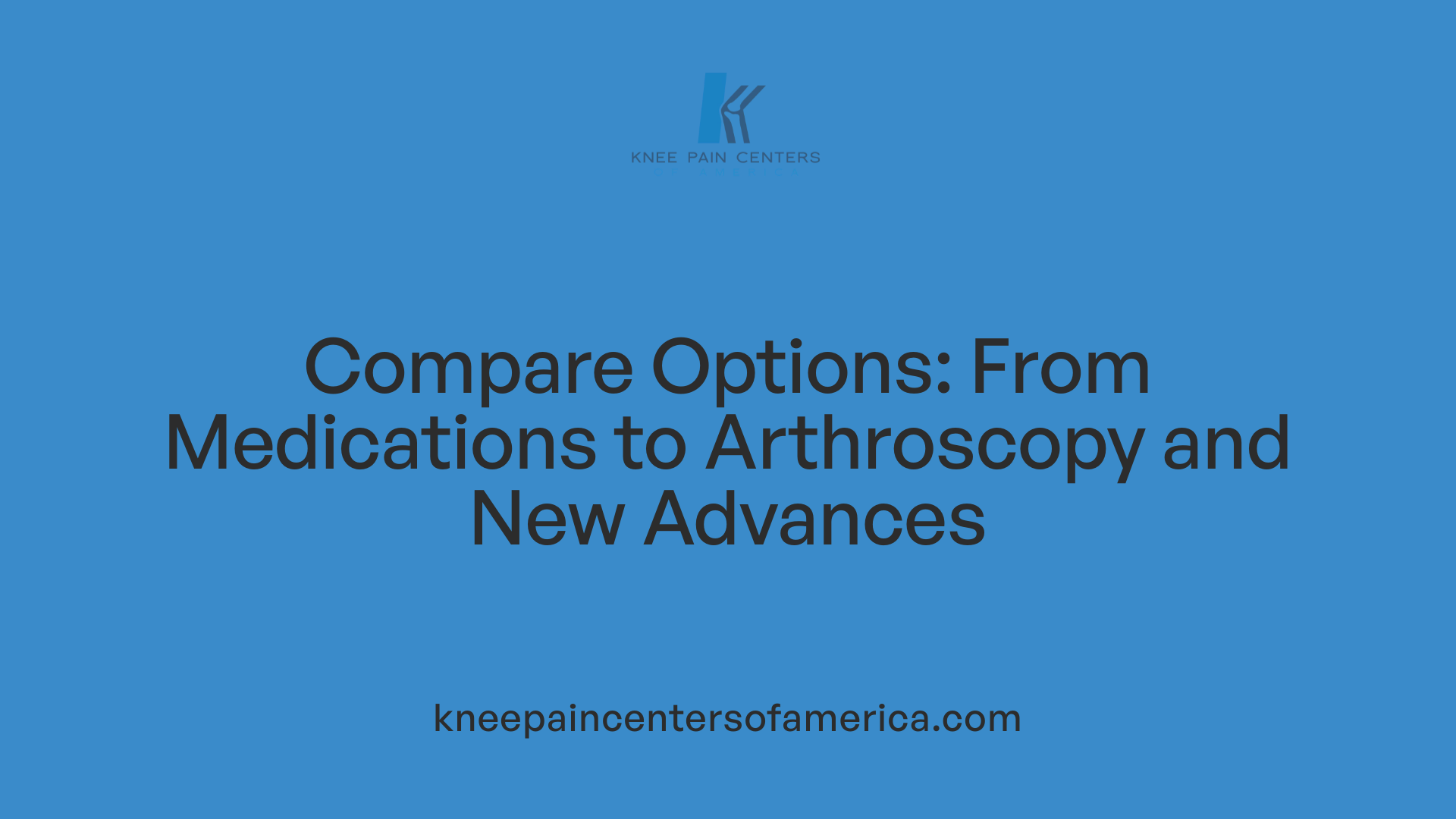
What are the common medical treatments for knee pain?
Common medical treatments for knee pain focus on reducing inflammation, controlling pain, and improving joint function. Medications like nonsteroidal anti-inflammatory drugs (NSAIDs) and acetaminophen are often first-line options to relieve discomfort. Physical therapy plays a crucial role by strengthening muscles around the knee and enhancing flexibility and stability. In addition, supportive devices such as knee braces provide mechanical support.
For targeted intervention, injections of corticosteroids, hyaluronic acid, or platelet-rich plasma (PRP) can help reduce inflammation and promote tissue repair within the joint. In chronic or severe cases where conservative measures are insufficient, surgical options like arthroscopy or total knee replacement may be required. Minimally invasive procedures such as genicular nerve blocks or radiofrequency ablation offer alternative pain management when other treatments fall short.
What treatment options are available specifically for osteoarthritis of the knee?
Osteoarthritis management typically begins with lifestyle modifications aimed at reducing joint stress and maintaining mobility. Weight loss and low-impact exercises such as swimming or cycling are effective strategies. Non-surgical treatments include physical therapy to strengthen surrounding muscles, NSAIDs to combat inflammation, and intra-articular injections (corticosteroids or hyaluronic acid) for symptom relief.
Supportive measures, including orthotics and assistive devices, help improve walking and reduce discomfort. If symptoms persist or worsen, surgical interventions like osteotomy or knee replacement may be considered. Treatment choices are tailored through shared decision-making, taking into account disease severity and patient preferences.
What role do physical therapy and lifestyle changes play in managing knee osteoarthritis?
Physical therapy is essential in the comprehensive management of knee osteoarthritis. By focusing on exercises that strengthen muscles around the knee and increase joint flexibility, therapy alleviates pain and improves function. Lifestyle modifications such as maintaining a healthy weight, engaging in regular low-impact activities, and following an anti-inflammatory diet reduce stress on the joint and slow disease progression.
Proper footwear and assistive devices lessen joint strain during movement. Adjunct therapies, including hot/cold treatments and patient education, empower individuals to manage symptoms more effectively. Together, these approaches enhance quality of life and support long-term joint health.
Introducing Genicular Artery Embolization: Mechanism and Procedure
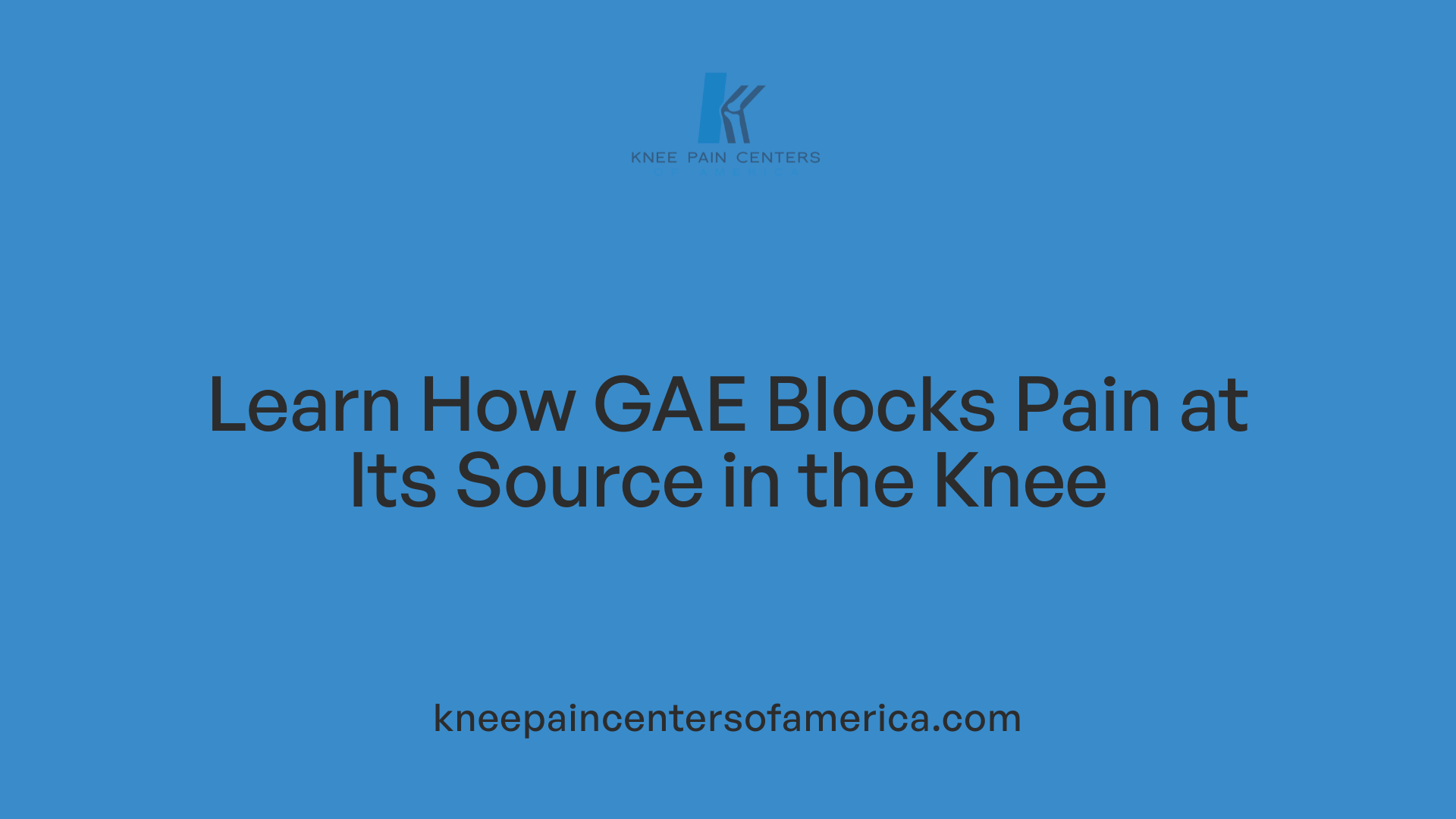
What is GAE?
Genicular Artery Embolization (GAE) is a minimally invasive, non-surgical treatment specifically developed to manage chronic knee pain caused by osteoarthritis. Instead of traditional surgery, GAE targets abnormal blood vessels fueling inflammation in the knee, aiming to provide significant pain relief while preserving the joint's natural structure.
How GAE Works
GAE functions by blocking targeted genicular arteries in the knee with microscopic particles. This reduces the blood flow responsible for inflammation around the joint lining, which reduces pain and slows cartilage damage. By limiting this vascular supply, GAE effectively interrupts pain signals and eases swelling associated with osteoarthritis.
Procedure Details and Patient Suitability
The procedure is performed by interventional radiologists using image guidance and involves inserting a small catheter through a tiny incision, typically at the groin. The catheter is guided to the knee’s blood vessels, where embolic agents are injected to block specific arteries. Patients remain awake under local anesthesia, avoiding general anesthesia risks.
GAE usually takes between 45 minutes to 2 hours and is done on an outpatient basis, allowing patients to return home the same day. It is suitable for individuals with mild to moderate knee osteoarthritis, especially those not responding to conservative treatments or who cannot tolerate surgery. Candidates generally range from 40 to 80 years old without severe joint deformities or infections.
| Aspect |
Description |
Additional Details |
| Nature of Treatment |
Minimally invasive, catheter-based embolization |
No large incisions or open surgery needed |
| Duration |
45-120 minutes |
Outpatient, same-day discharge |
| Anesthesia |
Local anesthesia |
Safer for patients with anesthesia risks |
| Target Patients |
Moderate knee osteoarthritis |
Prior surgery or conservative treatment failure; 40–80 years old |
| Mechanism |
Blocks genicular artery blood flow |
Reduces inflammation and pain |
GAE stands out as a promising procedure offering fast recovery, effective pain control, and an alternative to more invasive knee surgeries.
GAE’s Advantages: Safety, Effectiveness, and Recovery
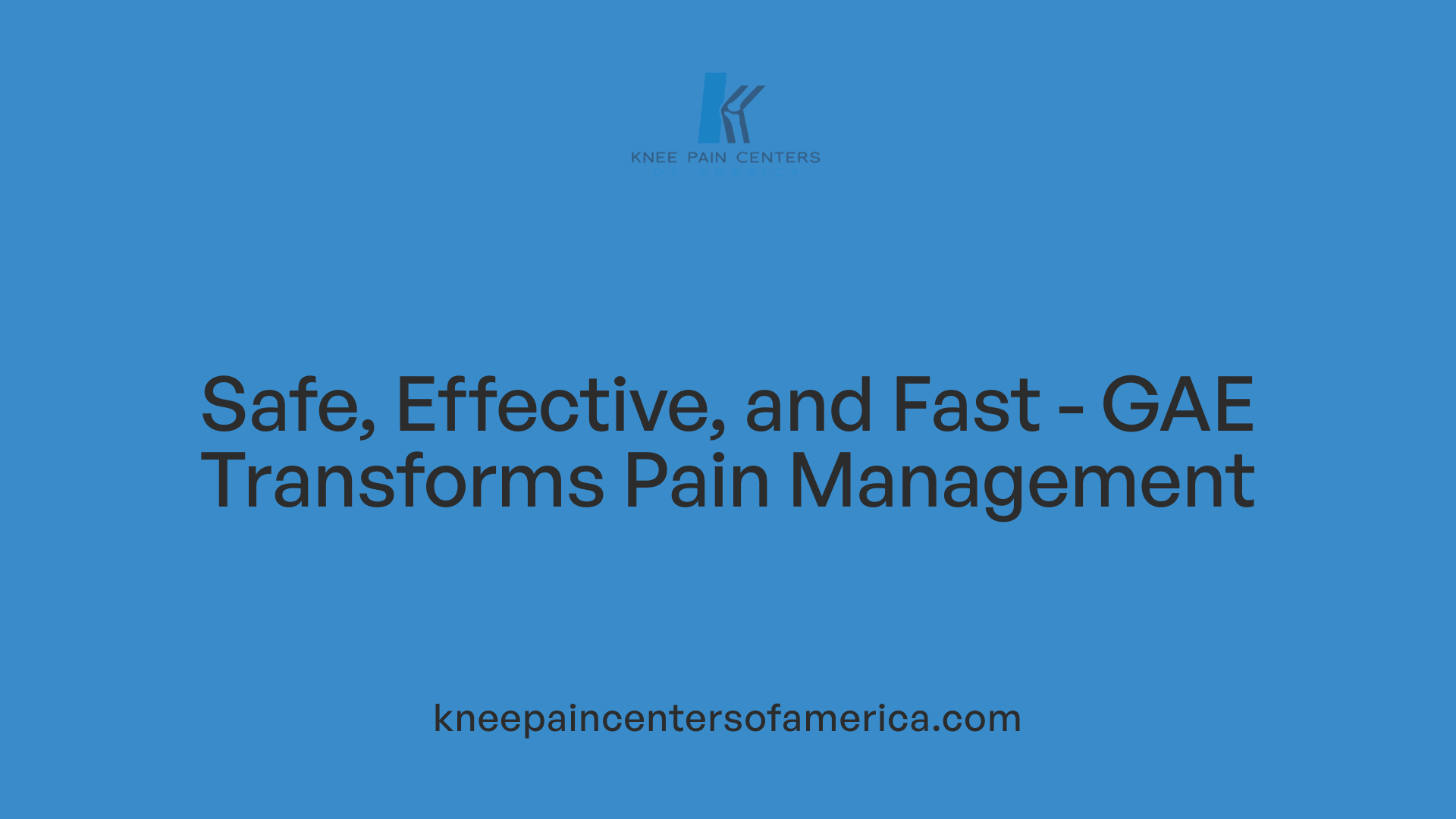
How Effective Is Genicular Artery Embolization (GAE)?
GAE is a proven treatment for knee pain related to osteoarthritis, showing impressive effectiveness across multiple studies. Technical success rates reach as high as 99.7%, with about 70-80% of patients reporting more than 50% pain reduction within one year. Many experience meaningful relief as quickly as the day after the procedure, with benefits lasting from one to four years.
What Is the Safety Profile of GAE?
GAE is recognized for its excellent safety profile. It is minimally invasive, performed through a small incision in the groin without large cuts or general anesthesia, thereby reducing risks like infection or nerve injury. Most side effects are mild and temporary, including minor skin discoloration and transient discomfort, which typically resolve without intervention. Unlike traditional surgery, GAE presents fewer complications and minimal swelling or pain after the procedure.
How Does Recovery From GAE Compare to Traditional Surgery?
Recovery following GAE is notably faster and less demanding than that of traditional knee surgeries such as replacement. Patients often return to daily activities the very next day without prolonged rehabilitation. The procedure usually lasts 45 to 90 minutes and is done on an outpatient basis, allowing same-day discharge. This quick recovery contrasts sharply with the extensive healing time and mobility restrictions common after knee replacement.
How Do Non-Surgical Treatments Like GAE Relieve Knee Osteoarthritis Symptoms?
Non-surgical options aim to reduce inflammation, alleviate pain, and enhance joint function by strengthening muscles, reducing cartilage stress, or using medications and injections. GAE specifically targets the increased blood flow and abnormal vessels contributing to knee inflammation and pain. By injecting tiny particles to block these vessels, it decreases inflammation and pain, improving mobility and potentially delaying or reducing the need for surgery.
| Aspect |
GAE Details |
Notes |
| Effectiveness |
70-80% experience significant pain relief; lasts up to 4 years |
Rapid improvement often within one day |
| Safety |
Minimal complications; minor, temporary side effects |
Avoids general anesthesia and large incisions |
| Recovery Time |
Return to normal activity next day |
Outpatient procedure, 45–90 minutes duration |
| Mechanism of Action |
Blocks abnormal blood vessels to reduce inflammation |
Targets synovial arterial hypervascularity |
GAE emerges as a safe, effective alternative bridging the gap between conservative therapies and surgery for knee osteoarthritis sufferers.
GAE’s Role in Filling Treatment Gaps and Delaying Surgery
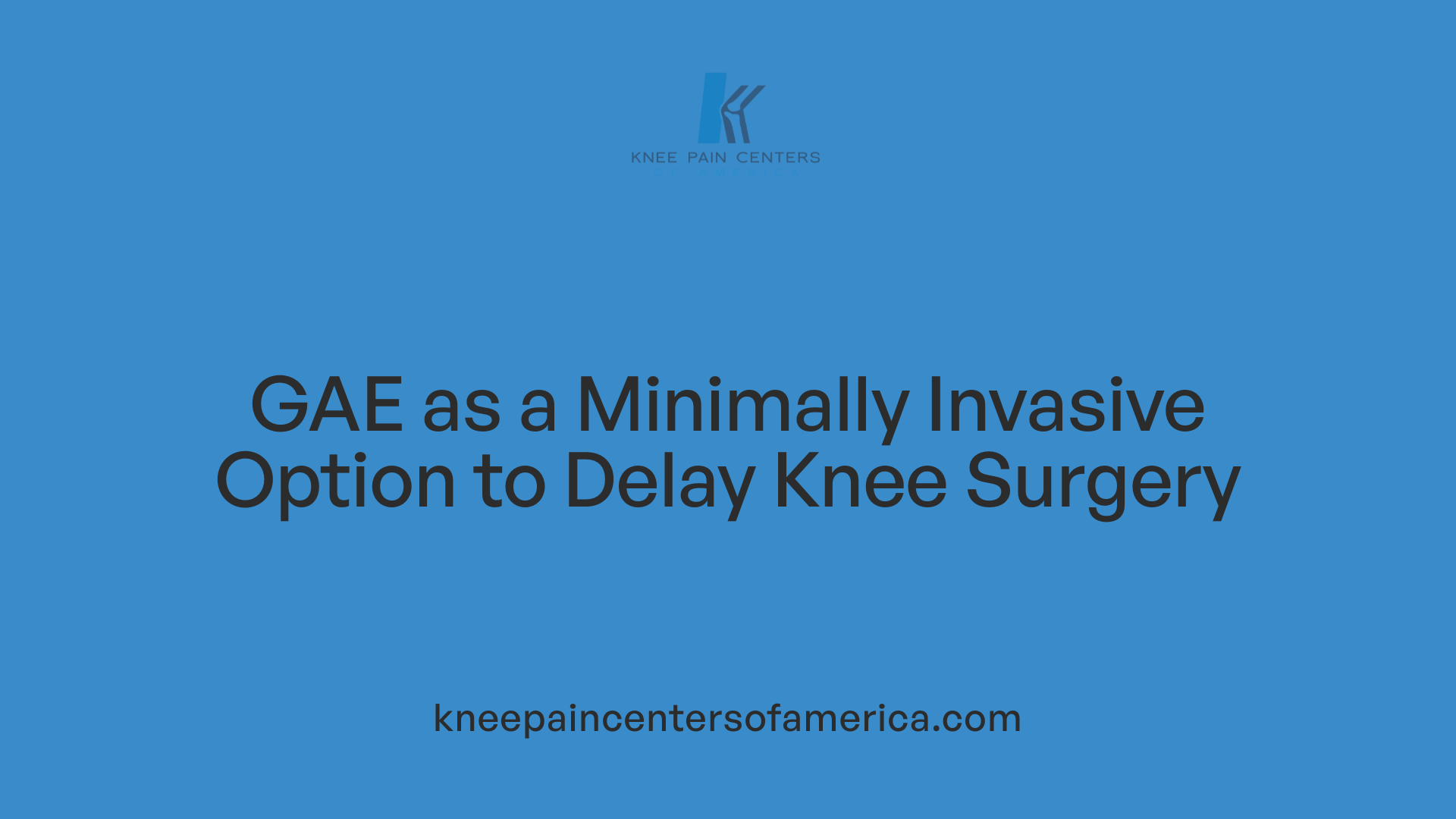
Candidates Best Suited for GAE
GAE is primarily recommended for patients with mild to moderate knee osteoarthritis who have not found relief from conservative treatments such as NSAIDs, physical therapy, or joint injections. It is especially valuable for individuals who cannot tolerate general anesthesia or are reluctant to undergo invasive surgery. Those with localized knee tenderness and moderate to severe pain but without advanced joint deformities often experience the most benefit.
GAE as an Alternative to Surgery
Surgery, including knee replacement, is generally reserved for advanced osteoarthritis when pain and functional limitations persist despite non-surgical measures. GAE provides a minimally invasive outpatient alternative that can delay or sometimes avoid the need for such procedures. Performed through a small pinhole incision with local anesthesia, GAE reduces inflammation by blocking aberrant blood vessels supplying the knee joint. This approach preserves the natural joint structure and offers faster recovery, allowing patients to resume activities much sooner than traditional surgery would permit.
Comparison with Other Non-Surgical Treatments
Compared to joint injections like corticosteroids—which may only provide a few months of relief and can potentially worsen osteoarthritis when repeated—GAE offers longer-lasting pain reduction with effects lasting from one to several years. Physical therapy is effective but can be costly and time-consuming, whereas GAE’s single outpatient procedure is typically completed within 1-2 hours. Additionally, GAE tends to have fewer complications, minimal pain and swelling, and no large incisions or prolonged rehabilitation.
When Is Surgery Recommended for Knee Osteoarthritis?
Surgery becomes necessary when symptoms significantly impair quality of life and do not respond to conservative measures. This includes total knee replacement or joint-preserving surgeries depending on severity. GAE is an effective option to fill the treatment gap prior to surgery, offering meaningful relief for many patients and potentially postponing or reducing the need for surgical intervention.
| Aspect |
GAE |
Traditional Surgery |
Other Non-Surgical Treatments |
| Invasiveness |
Minimally invasive outpatient |
Open surgery with large incisions |
Non-invasive or minimally invasive |
| Anesthesia |
Local |
General or spinal anesthesia |
N/A |
| Recovery Time |
Few days to 1-2 weeks |
Weeks to months |
Varies (immediate to weeks) |
| Pain Relief Duration |
Months to years |
Permanent joint change |
Weeks to months |
| Risks and Complications |
Minor, transient (skin discoloration, mild pain) |
Higher risk including infection, blood clots |
Variable depending on treatment |
Long-Term Benefits and Future Potential of GAE in Osteoarthritis Care
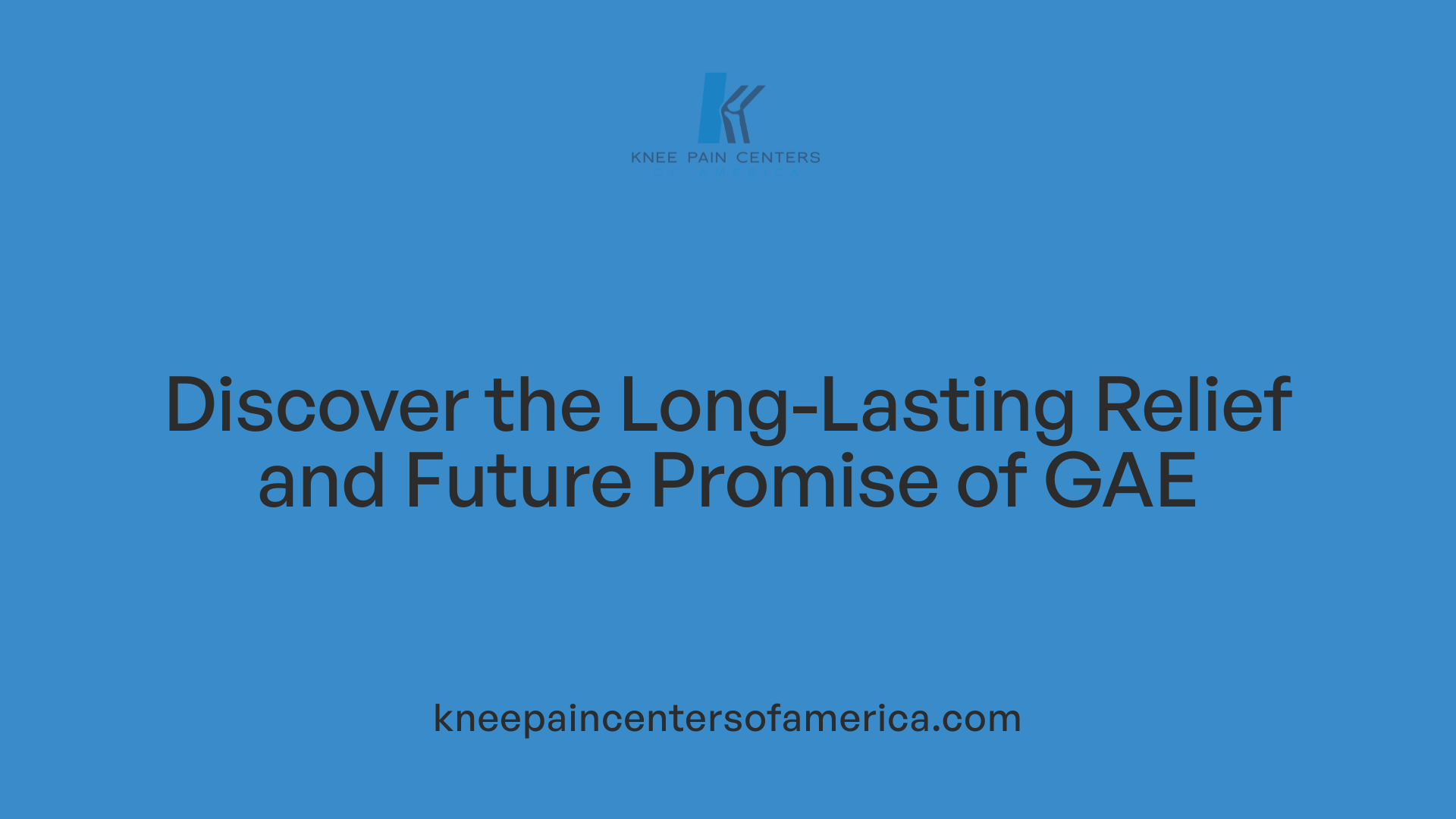
How Durable Are the Outcomes and What Are Patient Experiences?
Genicular Artery Embolization (GAE) offers durable pain relief, with many patients experiencing benefits lasting from one up to four years. Studies show that about 70% to 80% of patients report significant pain reduction one year after the procedure. Patients’ average pain scores have dropped from severe levels (around 8/10) to mild or moderate (about 3/10) within the first week, and improvements in knee function, such as increased walking distance and reduced dependence on mobility aids, have been documented.
How Does GAE Improve Quality of Life for Patients?
Patients undergoing GAE report enhancements not only in pain relief but also in their overall quality of life. One study observed that 87% of patients felt an improved quality of life one year post-treatment. By reducing inflammation and preserving the natural knee joint structures, GAE facilitates better mobility, quicker return to daily activities, and reduces the need for more invasive surgeries like knee replacement. These benefits translate into greater independence, less reliance on pain medications, and fewer side effects compared to traditional treatments.
What Are the Current Research Trends and Future Directions?
Ongoing research is focused on further validating GAE’s safety and efficacy through controlled clinical trials, expanding patient selection criteria, and exploring long-term outcomes beyond four years. Investigators are also examining how GAE might slow osteoarthritis progression and its potential role in delaying or avoiding total knee replacement surgery. Additionally, studies continue to refine procedural techniques and investigate combination therapies to maximize symptom relief and joint preservation.
| Aspect |
Details |
Additional Insight |
| Durability |
Pain relief lasting 1-4 years, significant improvements within weeks |
Over 70% report meaningful pain reduction at 12 months |
| Quality of Life |
Enhanced mobility and daily function, less reliance on aids and meds |
87% report improved life quality at 1 year |
| Research Focus |
Controlled trials, patient criteria, long-term benefits |
Potential to delay surgery and slow disease progression |
GAE is emerging as a promising, minimally invasive treatment offering substantial long-term benefits and improved patient outcomes for chronic knee osteoarthritis.
GAE: Transforming Knee Pain Management
Genicular Artery Embolization represents a transformative development in non-surgical pain relief for knee osteoarthritis. By offering a minimally invasive, outpatient procedure that delivers rapid and lasting symptom relief with a superior safety profile, GAE fills an important unmet need for patients who have exhausted conservative treatments or are unsuitable for surgery. Its ability to reduce inflammation, improve function, and delay or avoid joint replacement surgery highlights its potential to change standards of care and enhance quality of life for millions. As ongoing research deepens understanding and refines patient selection, GAE is poised to become an integral part of osteoarthritis management, heralding a new era in pain relief.
References